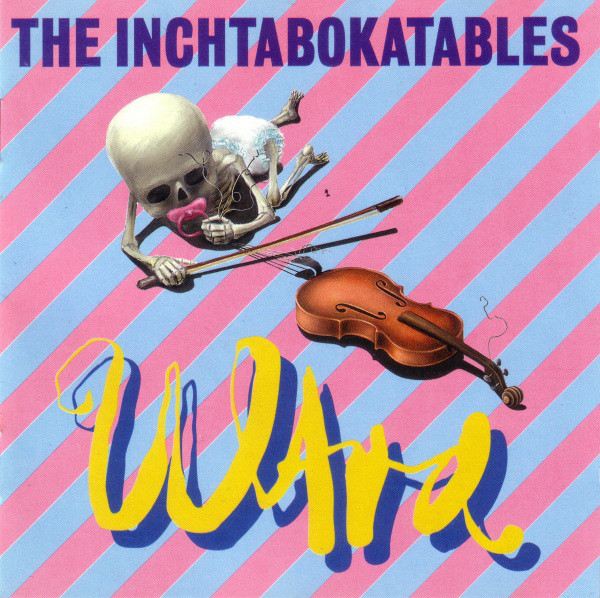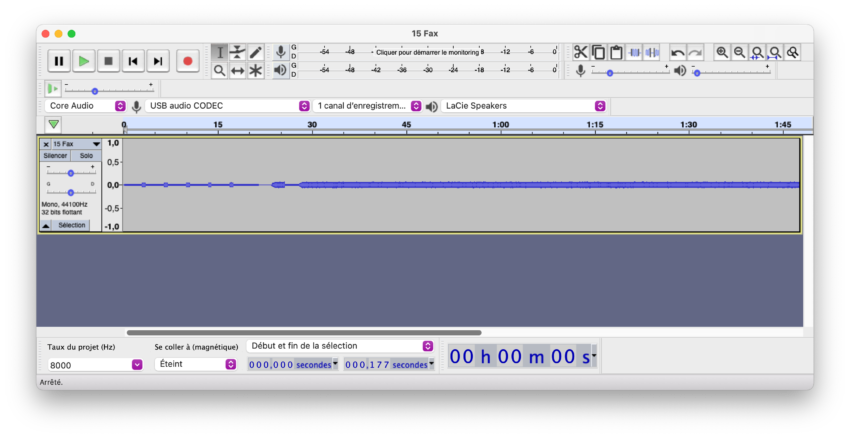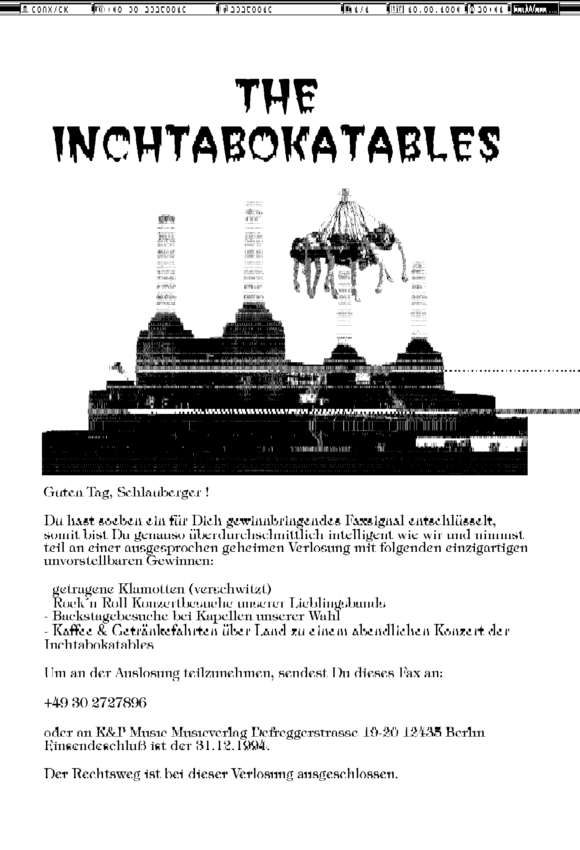This record isn’t exactly a vinyl containing data, but close to it. Because it’s even weirder: it’s a CD containing a fax.
Instead of repeating all the previous articles each time, I’ll refer you to the dedicated page, which explains what I do with vinyl records and lists all the pages containing programs, explanations, etc.
The album in question is Ultra, by The Inchtabokatables, dating back to 1994. The Wikipedia page for hidden tracks indicates that it contains the sound of an analog modem (just like the Discogs page) but several other sources mentioned a fax noise, and indeed: the track is named fax in iTunes. By the way, it’s track 15, whereas the disc cover only lists tracks 1 to 12.
Actually, when listening, it’s quite obvious if you’ve ever heard a fax (you’ll find plenty of examples here). What blocked me was something much dumber than « Finding out what it is. » It was « But how do you decode a fax? » Honestly, initially, I expected to find software for that. But no. I spare you the searches, but you have to compile a program (SpanDSP) with a specific parameter. So you have to go through these two steps.
./configure --enable-tests
make
Then, in the /tests directory, you’ll find fax_decode. The basic syntax is simple: just provide the WAV file as an argument. But beware, it must be in a specific format: a sampling frequency of 8 kHz and mono. As I tried unsuccessfully to convert the CD track (which is in 44.1 kHz) to 8 kHz initially with Audacity, here’s the trick: even if you change the frequency in the options, you must also indicate at the bottom left of the window that the project is in 8 kHz, otherwise it continues to export in 44.1 kHz. Let’s say this kind of dumb thing is part of the charm of open source.
But even after that, it didn’t work, whereas with the examples mentioned above, I got an image. I tried converting to 8 bits, filtering frequencies, etc. Then I had an epiphany looking at the signal heads. Instead of amplifying (what I usually do for signals), I reduced the amplitude (I don’t know if there’s an antonym for amplify), with a -5 dB amplification filter. And – magic – it worked. The decoding program gave me an image. Without this step, I had the carriers but lots of errors in the file.
The result is a TIFF image not super defined, but quite readable. And with the magic of the Apple M1 (and some manual corrections).
Guten Tag, Schlauberger!
Du hast soeben ein für Dich gewinnbringendes faxsignal entschlüsselt, somit bist. Du genauso überdlurchschmittlich intelligent, wie wir und nimmst, teil an einer ausgesprochen geheimen Verlosung mit folgenden einzigartigen unvorstellbaren Gewinnen:-Getragene Klamotten (verschwitzt)
-Rock’n Roll Konzertbesuche unserer Lieblingsbande
-Backstagebesuche bei Kapellen unserer Wall
-Kaffee & Getränkefalten über Land zu eine m absendlichen Konzert der Inchtabokatables.Um an der Auslosung teilzunehmen, sendest Du dieses fax an:
+49 30 2727896
oder an K&P Music Musicverlag Befreggerstrassc. 19-20 12445 Berlin
Eingendeschluss ist der 31.12.1994.
Der Rechteweg ist bei dieser Verlosung ausgeschlossen.
Here’s the text (with probably some mistakes, my German is rusty).
Good day, smarty-pants!
You have just decrypted a fax signal that is profitable for you, thus you are. You are just as exceptionally intelligent as we are and participate in an extremely secret raffle with the following unique and unimaginable prizes:-Worn clothes (sweaty)
-Rock’n Roll concert visits by our favorite bands
-Backstage visits to chapels on our wall
-Coffee & beverage wrinkles across the country to a mailing concert of the Inchtabokatables.To participate in the draw, send this fax to:
+49 30 2727896
or to K&P Music Musicverlag Befreggerstrassc. 19-20 12445 Berlin
The deadline for submissions is December 31, 1994.
The legal process is excluded from this raffle.
So, obviously, I’m about 25 years too late. And I wonder if anyone decoded the fax at the time.





